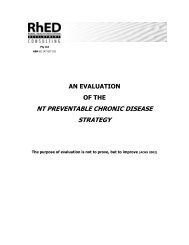DHF Annual Report 2009 - NT Health Digital Library - Northern ...
DHF Annual Report 2009 - NT Health Digital Library - Northern ...
DHF Annual Report 2009 - NT Health Digital Library - Northern ...
You also want an ePaper? Increase the reach of your titles
YUMPU automatically turns print PDFs into web optimized ePapers that Google loves.
where Aboriginal people make up the majority of ourclient base. Understanding this policy and how the success now forms part of the orientation for new staffin our agency. Evaluation of the orientation programindicates that staff understand the importance ofeffectively engaging in the cross cultural service spaceand have a real hunger for more information and moretraining to help them do well in the Territory’s Aboriginaldominated service environment. The Department willin the coming year, respond to this and build yet bettercross cultural competence in staff and services.The employment of Aboriginal people stands as a strongpolicy objective within the agency. Already about 10%of staff are Aboriginal or Torres Strait Islander and wecontinue to look for better ways of attracting Aboriginalpeople to the agency. The Department’s effort to build aschool career pipeline continues with an ongoing focuson apprenticeships and engagement with Aboriginalstudents. Creating new roles within the Departmentin response to new opportunities and demands alsoprovides an opportunity to grow Aboriginal employment.For example the creation of the Aboriginal CommunityWorker role as an important bridge between familiesfunction gap and generates local job opportunities in theDepartment for Aboriginal people in the bush.The Department’s commitment is not just in trying toattract new Aboriginal staff but in providing developmentopportunities for existing staff so that they can buildlong term careers in our agency. <strong>2009</strong>–10 saw thecommencement of the second intake of the Stepping UpProgram. Open to Aboriginal staff across the Departmentthe Program provides a structured career developmentopportunity where individual career developmentplans are mapped and negotiated for the successfulparticipants. These plans include access to formalcourses and placements in new roles that are meant toexpand the experience and competence of participants.Eighteen Aboriginal staff from different parts of theTerritory have now been part of this innovative initiativeand early indicators show that the Program is valuedand producing results.Alongside of these efforts to engage Aboriginal staff inmore senior roles are the Department’s efforts to engageAboriginal people more broadly in the planning, provisionand evaluation of health and families services in theTerritory. Over the year the Department has been partof a program of development that seeks to encourageAboriginal participation in the delivery of services. WithAMSA<strong>NT</strong> and the Australian Government, the Territoryhas been working to map, encourage and facilitate thedevelopment of regional arrangements that will integrateTerritory funded and Australian Government fundedprimary health care services into a single regional modelin which Aboriginal communities play the dominantmanagement role.Integration under this regionalised model will provide aequitable distribution of resources and services, bettertargeted at local needs and managed by locals from engagement, not just in terms of making the system abetter more responsive operation, but also in terms ofdelivering healthier outcomes to those who get involved.The policy foundation for this work, Pathways toCommunity Control, was developed here in the Territoryand is increasingly gaining national recognition as a wellstructured model that has potential in many locationsacross the country.Better skilling our people, better integrating andexpanding services on the ground are essential to ahealthier future for Aboriginal Territorians. Being able tobetter monitor our efforts and the outcomes from them isalso vital. In the Territory Departmental and communitycontrolled health services provide the great majority ofprimary health care services to Aboriginal Territorians.Clients sometimes move between providers andensuring that critical health information is available at thepoint of service is essential if we are to do the best wecan. Many thousands of Aboriginal people in the bushhave agreed to join a shared electronic health recordsystem and over the past year we have seen continuingsuccess and use of this system. Similarly, Aboriginalcommunity controlled services and the Departmenthave agreed to consistent reporting against a numberof key performance indicators. This year more than 80individual community based reports against those keyindicators were released to providers. This developmentprovides an example of co-operation in the interests ofclient needs and better performance.There are many challenges in moving to reform thedelivery of health and wellbeing services to Aboriginal see real promise in the work that the Department hasundertaken but they too will no doubt see, as we do, thatthere remains much to be done. Doing better requiresan ongoing commitment to review and adaptation ascircumstances change but also sustaining what works inan increasingly complex policy and service environment.20Department <strong>Health</strong> and Families
















